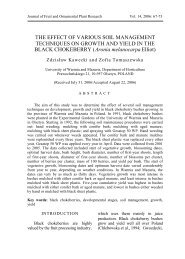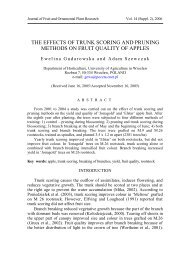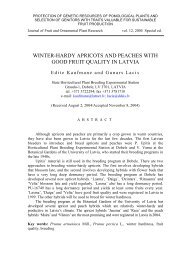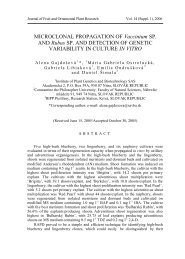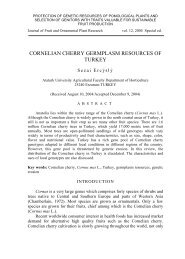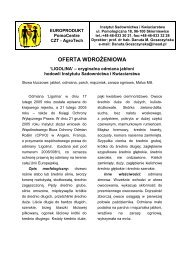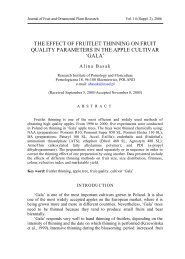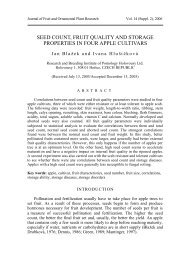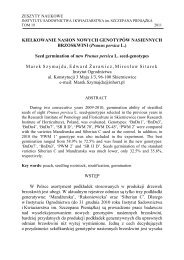Use of genetic resources in apple breeding and for sustainable fruit ...
Use of genetic resources in apple breeding and for sustainable fruit ...
Use of genetic resources in apple breeding and for sustainable fruit ...
Create successful ePaper yourself
Turn your PDF publications into a flip-book with our unique Google optimized e-Paper software.
M. Kellerhals et al.resistances <strong>in</strong> a cultivar. Examples <strong>for</strong> molecular selection towards genotypeswith such pyramided <strong>genetic</strong> resistance aga<strong>in</strong>st scab (Venturia <strong>in</strong>aequalis) <strong>and</strong>powdery mildew (Podosphaera leucotricha) are promis<strong>in</strong>g. Molecularmarkers are available which allow detect<strong>in</strong>g the Vf, Vr <strong>and</strong> Vbj scab resistance(Tartar<strong>in</strong>i et al., 1999; Hemmat et al, 2002; Gygax et al., 2004) <strong>and</strong> the Pl 1 ,Pl 2 , Pld <strong>and</strong> Plw mildew resistance (Markussen et al., 1995; Seglias <strong>and</strong>Gessler, 1997; James <strong>and</strong> Evans, 2004). At Agroscope FAW Wädenswil, weachieved progress <strong>in</strong> markerassisted selection by establish<strong>in</strong>g a massselection(Frey et al., 2004) <strong>and</strong> by further reduc<strong>in</strong>g cost. We are analys<strong>in</strong>g upto eight markers <strong>in</strong> a s<strong>in</strong>gle multiplex reaction. Systems have been establishedthat allow to switch from a SCARbased screen<strong>in</strong>g to a microsatellite basedscreen<strong>in</strong>g on a automated fragment analyzer.As MacHardy et al. (2001) stated, all major resistances <strong>in</strong> <strong>apple</strong> such asVf, Vm, Vr are ephemeral. It is there<strong>for</strong>e necessary to def<strong>in</strong>e alternativestrategies <strong>for</strong> durable resistance. Besides the pyramid<strong>in</strong>g <strong>of</strong> major genes the<strong>in</strong>clusion <strong>of</strong> partial resistance present <strong>in</strong> <strong>genetic</strong> <strong>resources</strong> might be promis<strong>in</strong>g.In the framework <strong>of</strong> the European DARE project local European cultivarswere exam<strong>in</strong>ed as sources <strong>for</strong> durable scab resistance <strong>in</strong> <strong>apple</strong> (Laurens et al.,2004). It is known that the Vf scab resistance widely used <strong>in</strong> <strong>apple</strong> breed<strong>in</strong>gprogrammes can be overcome by specific races or stra<strong>in</strong>s <strong>of</strong> the fungus.Dur<strong>in</strong>g this research very diverse <strong>and</strong> complex resistance behaviours havebeen found: the cultivars which showed the widest range <strong>of</strong> resistance weremostly local cultivars <strong>and</strong> some newly selected hybrids comb<strong>in</strong><strong>in</strong>g majorgenes <strong>and</strong> partial resistance.To achieve a comparable level <strong>of</strong> resistance as with major genes, severalquantitative resistance loci would have to be comb<strong>in</strong>ed. Liebhard et al., 2003per<strong>for</strong>med a QTL analysis based on a <strong>genetic</strong> l<strong>in</strong>kage map that wasconstructed by us<strong>in</strong>g a segregat<strong>in</strong>g population <strong>of</strong> the cross between the <strong>apple</strong>cultivars Fiesta <strong>and</strong> Discovery. The progeny was observed <strong>for</strong> three years atthree different sites <strong>in</strong> Switzerl<strong>and</strong> <strong>and</strong> field resistance aga<strong>in</strong>st <strong>apple</strong> scab wasassessed. The QTL analysis revealed 8 genomic regions where six conferredresistance aga<strong>in</strong>st leaf scab <strong>and</strong> two conferr<strong>in</strong>g resistance aga<strong>in</strong>st <strong>fruit</strong> scab.However, the effectiveness <strong>of</strong> these detected QTL’s has to be confirmed athigher disease levels <strong>and</strong> <strong>in</strong> other <strong>genetic</strong> backgrounds.There is also scope <strong>for</strong> breed<strong>in</strong>g fireblight resistant <strong>apple</strong> <strong>and</strong> pearcultivars by exploit<strong>in</strong>g <strong>genetic</strong> variation <strong>in</strong> germplasm <strong>and</strong> by develop<strong>in</strong>gQTL markers. Fire blight, caused by the bacterium Erw<strong>in</strong>ia amylovora, is themost serious bacterial disease <strong>of</strong> pomaceous <strong>fruit</strong> trees. Forsl<strong>in</strong>e <strong>and</strong>Aldwickle (2002) have screened the USDA Apple Collection at Geneva N.Y.<strong>in</strong>clud<strong>in</strong>g <strong>apple</strong> germplasm from Asia <strong>and</strong> Europe <strong>for</strong> natural occurrence <strong>of</strong>fire blight. For fire blight no major resistance genes have been found.There<strong>for</strong>e it seems reasonable to opt <strong>for</strong> QTL’s.56J. Fruit Ornam. Plant Res. Special ed. vol. 12, 2004: 5362




